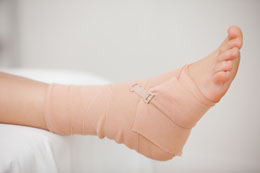Inner ankle pain is a common scenario with people who are into sports, especially those that involve running, jumping, sprinting, and the like. Know how to treat ankle pain with the help of a few self care measures.

The ankle bears tremendous amount of body weight, especially when someone runs or jogs. A case of inner ankle pain which does not last more than a day, may not be a cause of concern. A prolonged pain, however, may sound an alarm against something serious or severe. This stresses the importance of getting the case evaluated by a doctor. It becomes all the more important when the pain occurs post surgery.
How to Relieve Ankle Pain
The treatment depends on what has caused the pain. If it is an injury then the following tips may offer help in managing the condition. However, if an underlying medical condition is the cause, then appropriate treatment measures must be taken.
☞ Sharp inner ankle pain can be managed by taking plenty of rest and patients are advised to stay off their sporting activities, until the pain subsides. If the injury is mild, then resting alone can relieve the pain.
☞ If the ankle pain is caused by an injury, more often than not, it is followed by swelling. To reduce the swelling and the pain, it is recommended to ice the area as soon as possible. Wrap ice in a towel and compress it against the affected area (never use ice directly on the swollen area). This must be done for 10 - 15 minutes four times a day for two days. However, one must be careful not to ice the area for too long as it may cause tissue damage. Keeping the affected ankle at a level that is higher than that of the heart, aids in reducing the swelling and pain in the ankle. So while sleeping or sitting, placing two pillows under the ankle would help.
☞ One can use heating pads to treat the area only if the pain is chronic, like it is in the case of rheumatoid arthritis. Heat helps in relaxing and loosening tissues, and stimulate blood flow in the aching area. The same can also be helpful in treating ankle pain that might have occurred from overuse injuries.
☞ To manage the pain, and to keep it from worsening, one must try to put as less weight as possible on the affected ankle. One way to do that is to use crutches or a cane. Using footwear modifications or orthotics also offer a great deal of help in keeping the pain from aggravating.
☞ Coming to the medicines to be administered for treating the condition include anti-inflammatory drugs. Common ones include ibuprofen and naproxen. There are these chemicals in the body which are known as COX-2 enzymes and prostaglandins. The body's reaction to stress or injuries causes an overproduction of such chemicals, which in turn cause inflammation and pain. So, what these inflammatory medicines do is inhibit the production of these chemicals.
☞ If the ankle pain is caused by an injury, then it may take a few days to months for recovery. Once the pain and swelling are gone, it is recommended that the patient starts exercising to strengthen the ankle. This would help in stretching the tendons and loosening the tightness. Massaging the area, with essential oils, also proves beneficial as it stimulates blood circulation. However, such exercises must be started only when recommended by the patient's health care provider.
What Causes Ankle Pain?
Needless to say, injury to bones, ligaments or tendons in the ankle is the most common cause of this condition. Another common cause is ankle sprain, which results when the ankle gets twisted or turned in an awkward manner. Apart from these, pain in the inner ankle could have several medical conditions to be blamed for. Some common offenders in the list include Achilles tendinitis, Achilles tendon rupture, septic arthritis, injured ankle or foot, osteoarthritis and even gout. Also, conditions like avulsion fracture, pseudogout, rheumatoid arthritis may bring about the occurrence of this condition.
How Can You Prevent Ankle Injury
The very first thing to consider in preventing the onset of this condition, is to wear proper running shoes. This is more important for people who lack normal or perfect gait or stride. Wearing improperly fitting shoes can run a risk of an injury and result in pain in the inner ankle. Avoid running on uneven surfaces and on loose gravel. Such surfaces can easily create an imbalance in the coordination of the parts involved in running, and recuperate in an injury.
To conclude, if you are suffering from inner ankle pain, then take a break immediately, or modify the activity. Apply ice compresses and take medications. However, if the pain comes back or tends to bother you for long, then this gives you a good reason to get yourself checked by a doctor.
Disclaimer:
The information provided in this article is solely for educating the reader. It is not intended to be a substitute for the advice of a medical expert.


 The ankle bears tremendous amount of body weight, especially when someone runs or jogs. A case of inner ankle pain which does not last more than a day, may not be a cause of concern. A prolonged pain, however, may sound an alarm against something serious or severe. This stresses the importance of getting the case evaluated by a doctor. It becomes all the more important when the pain occurs post surgery.
The ankle bears tremendous amount of body weight, especially when someone runs or jogs. A case of inner ankle pain which does not last more than a day, may not be a cause of concern. A prolonged pain, however, may sound an alarm against something serious or severe. This stresses the importance of getting the case evaluated by a doctor. It becomes all the more important when the pain occurs post surgery.